Mentoring Underachieving Students: Learning, Teaching, and Assessment
VerifiedAdded on 2023/06/10
|17
|5455
|245
Essay
AI Summary
This essay addresses the challenge of supporting underachieving students in clinical placements, focusing on a second-year student with a history of underperformance. It emphasizes the critical role of mentors in guiding and assessing students, highlighting key qualities of effective mentors such as communication, preparedness, and compassion. The essay explores various learning styles, particularly the auditory learning style of the mentee, and applies learning theories like cognitive, andragogy, and behavioral learning theory to enhance the student's learning experience. It further discusses the importance of a positive clinical learning environment, SWOT analysis, SMART goals, accurate record-keeping, and the role of self-awareness and emotional intelligence in mentoring. The essay also underscores the significance of orientation, team relationships, two-way feedback, and timely assessments for promoting learning and ensuring successful outcomes, concluding with recommendations for future mentoring practices.
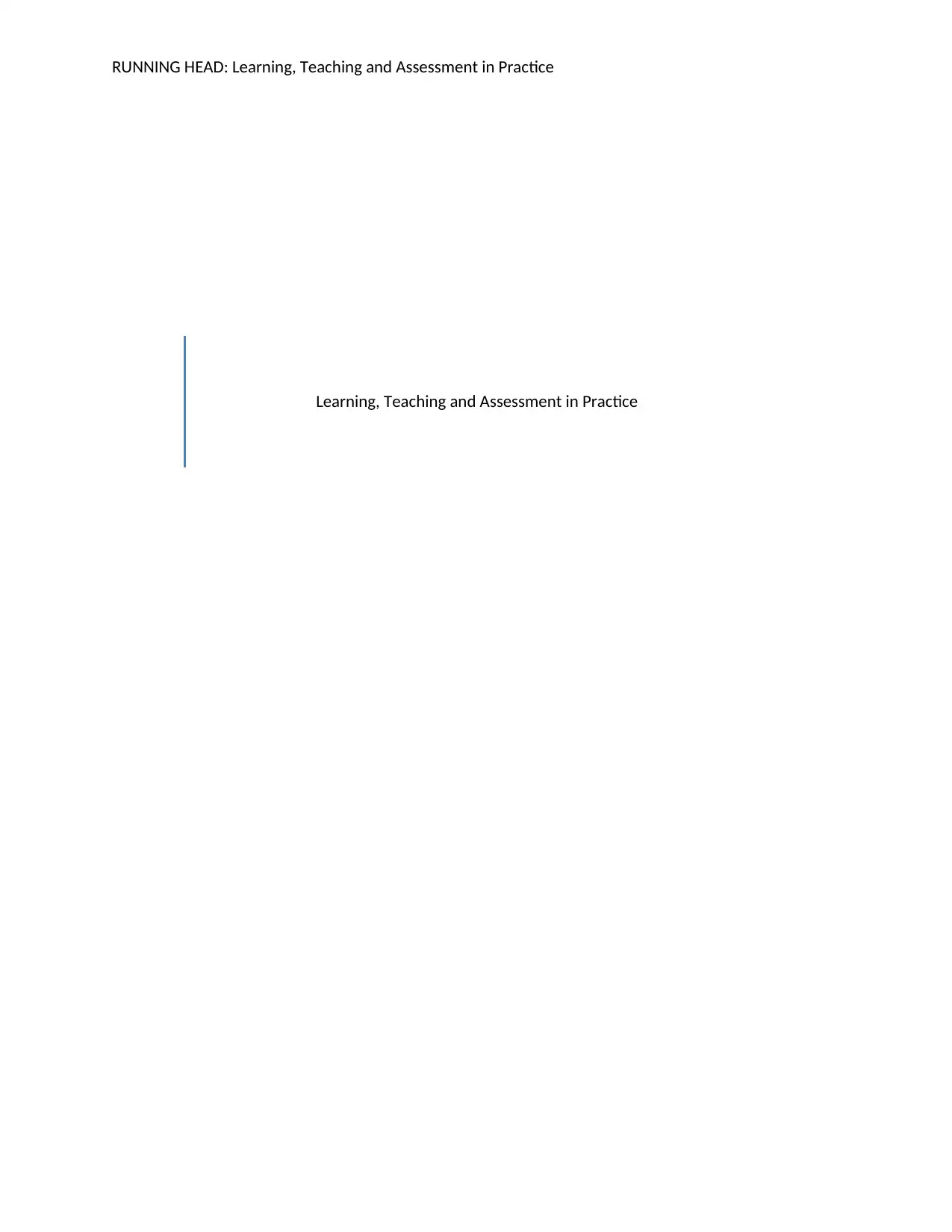
RUNNING HEAD: Learning, Teaching and Assessment in Practice
Learning, Teaching and Assessment in Practice
Learning, Teaching and Assessment in Practice
Paraphrase This Document
Need a fresh take? Get an instant paraphrase of this document with our AI Paraphraser
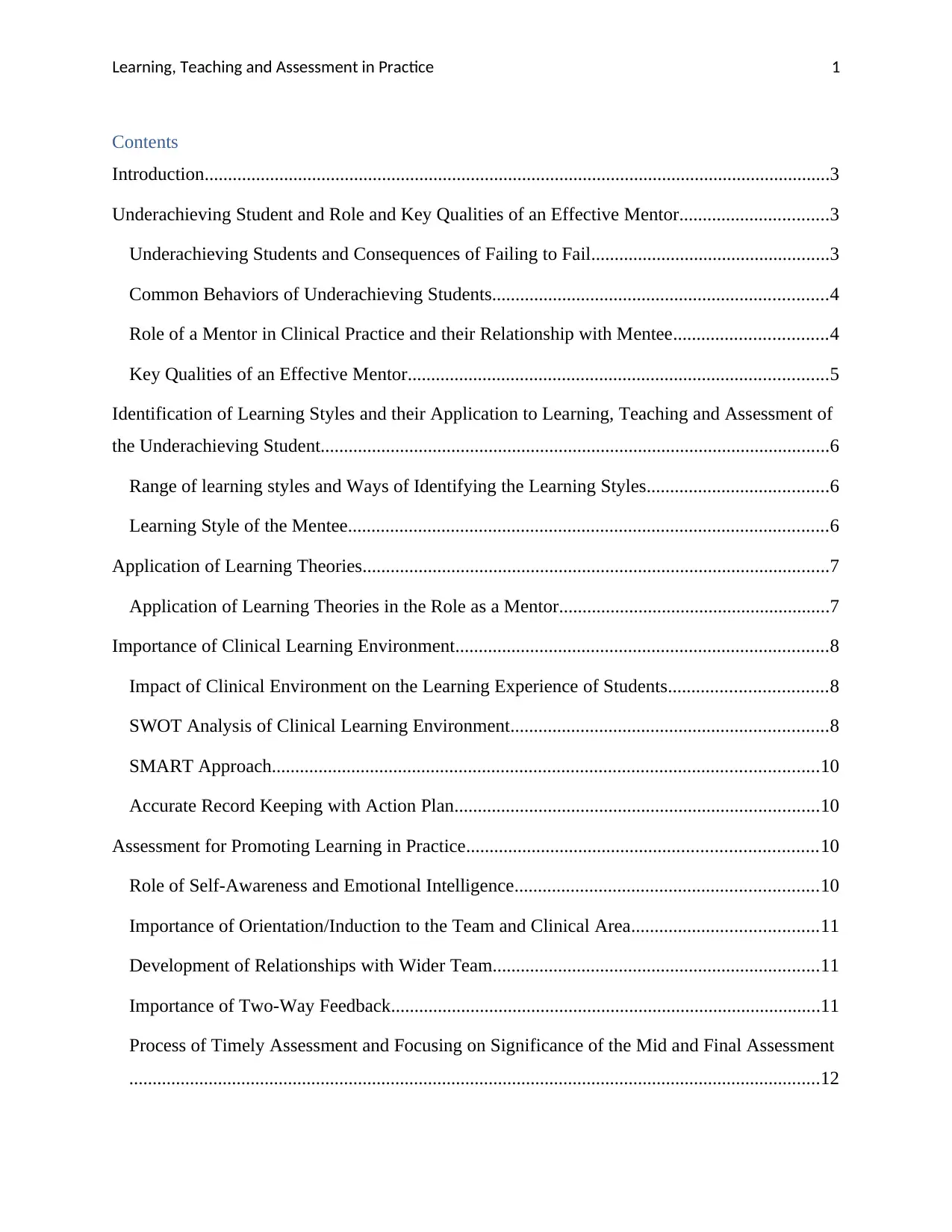
Learning, Teaching and Assessment in Practice 1
Contents
Introduction......................................................................................................................................3
Underachieving Student and Role and Key Qualities of an Effective Mentor................................3
Underachieving Students and Consequences of Failing to Fail...................................................3
Common Behaviors of Underachieving Students........................................................................4
Role of a Mentor in Clinical Practice and their Relationship with Mentee.................................4
Key Qualities of an Effective Mentor..........................................................................................5
Identification of Learning Styles and their Application to Learning, Teaching and Assessment of
the Underachieving Student.............................................................................................................6
Range of learning styles and Ways of Identifying the Learning Styles.......................................6
Learning Style of the Mentee.......................................................................................................6
Application of Learning Theories....................................................................................................7
Application of Learning Theories in the Role as a Mentor..........................................................7
Importance of Clinical Learning Environment................................................................................8
Impact of Clinical Environment on the Learning Experience of Students..................................8
SWOT Analysis of Clinical Learning Environment....................................................................8
SMART Approach.....................................................................................................................10
Accurate Record Keeping with Action Plan..............................................................................10
Assessment for Promoting Learning in Practice...........................................................................10
Role of Self-Awareness and Emotional Intelligence.................................................................10
Importance of Orientation/Induction to the Team and Clinical Area........................................11
Development of Relationships with Wider Team......................................................................11
Importance of Two-Way Feedback............................................................................................11
Process of Timely Assessment and Focusing on Significance of the Mid and Final Assessment
....................................................................................................................................................12
Contents
Introduction......................................................................................................................................3
Underachieving Student and Role and Key Qualities of an Effective Mentor................................3
Underachieving Students and Consequences of Failing to Fail...................................................3
Common Behaviors of Underachieving Students........................................................................4
Role of a Mentor in Clinical Practice and their Relationship with Mentee.................................4
Key Qualities of an Effective Mentor..........................................................................................5
Identification of Learning Styles and their Application to Learning, Teaching and Assessment of
the Underachieving Student.............................................................................................................6
Range of learning styles and Ways of Identifying the Learning Styles.......................................6
Learning Style of the Mentee.......................................................................................................6
Application of Learning Theories....................................................................................................7
Application of Learning Theories in the Role as a Mentor..........................................................7
Importance of Clinical Learning Environment................................................................................8
Impact of Clinical Environment on the Learning Experience of Students..................................8
SWOT Analysis of Clinical Learning Environment....................................................................8
SMART Approach.....................................................................................................................10
Accurate Record Keeping with Action Plan..............................................................................10
Assessment for Promoting Learning in Practice...........................................................................10
Role of Self-Awareness and Emotional Intelligence.................................................................10
Importance of Orientation/Induction to the Team and Clinical Area........................................11
Development of Relationships with Wider Team......................................................................11
Importance of Two-Way Feedback............................................................................................11
Process of Timely Assessment and Focusing on Significance of the Mid and Final Assessment
....................................................................................................................................................12
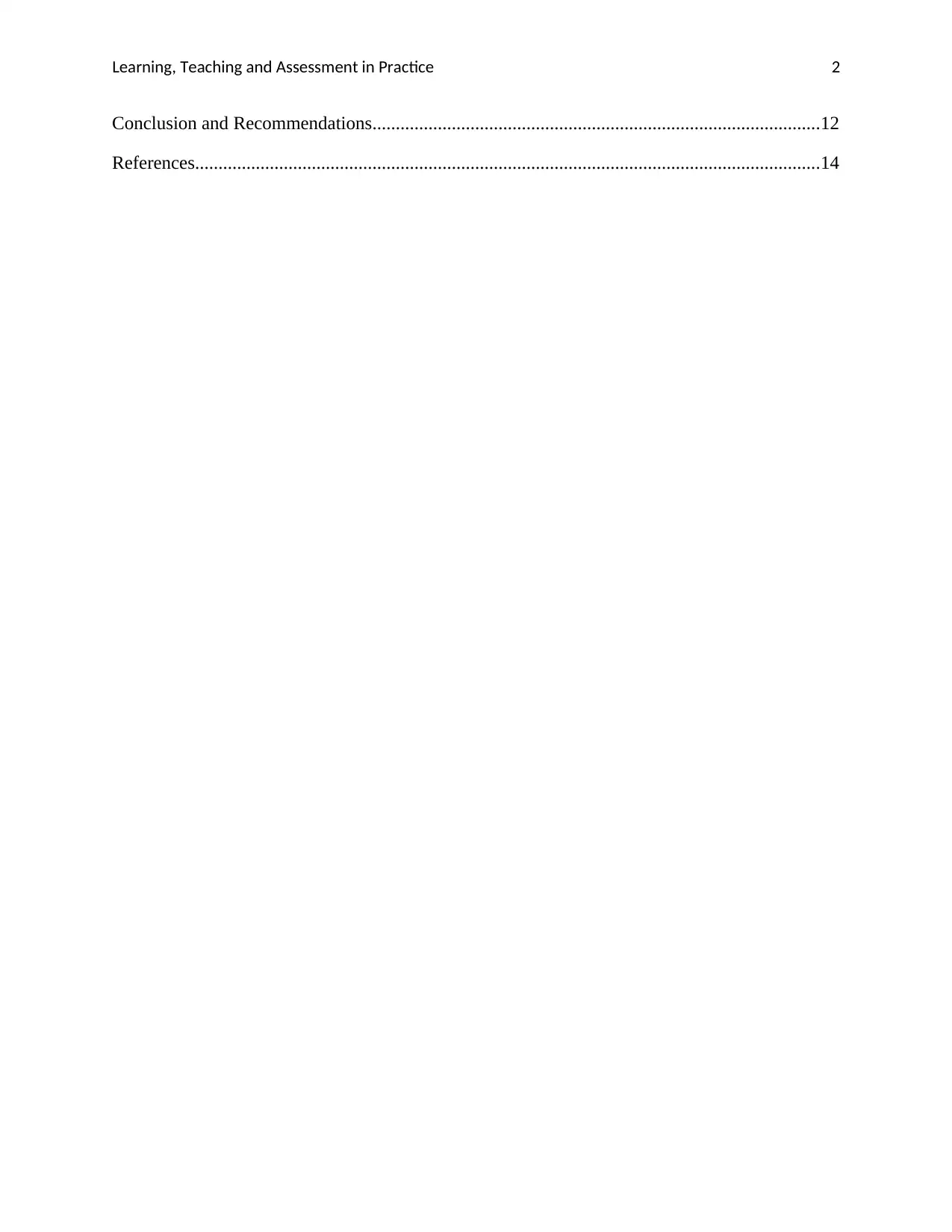
Learning, Teaching and Assessment in Practice 2
Conclusion and Recommendations................................................................................................12
References......................................................................................................................................14
Conclusion and Recommendations................................................................................................12
References......................................................................................................................................14
⊘ This is a preview!⊘
Do you want full access?
Subscribe today to unlock all pages.

Trusted by 1+ million students worldwide
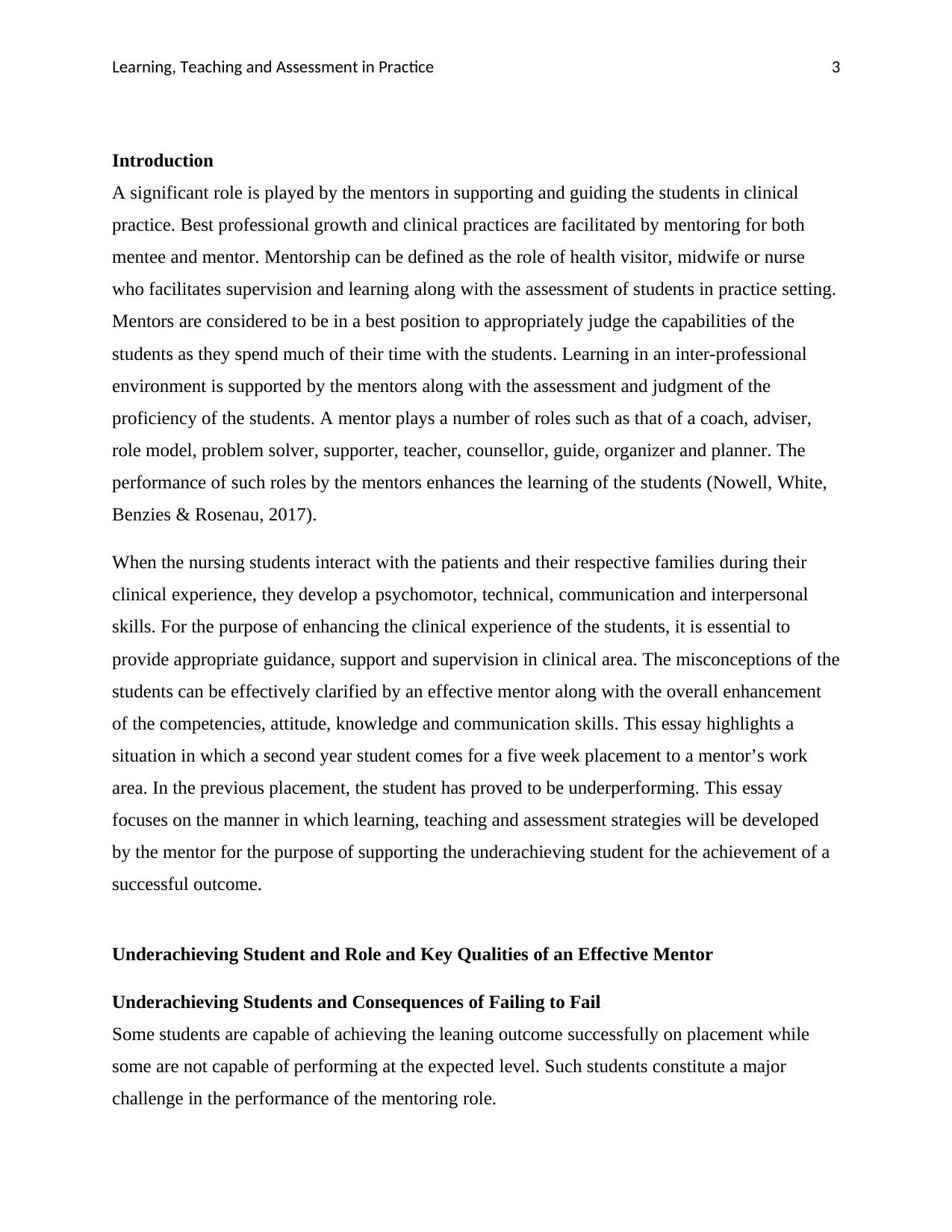
Learning, Teaching and Assessment in Practice 3
Introduction
A significant role is played by the mentors in supporting and guiding the students in clinical
practice. Best professional growth and clinical practices are facilitated by mentoring for both
mentee and mentor. Mentorship can be defined as the role of health visitor, midwife or nurse
who facilitates supervision and learning along with the assessment of students in practice setting.
Mentors are considered to be in a best position to appropriately judge the capabilities of the
students as they spend much of their time with the students. Learning in an inter-professional
environment is supported by the mentors along with the assessment and judgment of the
proficiency of the students. A mentor plays a number of roles such as that of a coach, adviser,
role model, problem solver, supporter, teacher, counsellor, guide, organizer and planner. The
performance of such roles by the mentors enhances the learning of the students (Nowell, White,
Benzies & Rosenau, 2017).
When the nursing students interact with the patients and their respective families during their
clinical experience, they develop a psychomotor, technical, communication and interpersonal
skills. For the purpose of enhancing the clinical experience of the students, it is essential to
provide appropriate guidance, support and supervision in clinical area. The misconceptions of the
students can be effectively clarified by an effective mentor along with the overall enhancement
of the competencies, attitude, knowledge and communication skills. This essay highlights a
situation in which a second year student comes for a five week placement to a mentor’s work
area. In the previous placement, the student has proved to be underperforming. This essay
focuses on the manner in which learning, teaching and assessment strategies will be developed
by the mentor for the purpose of supporting the underachieving student for the achievement of a
successful outcome.
Underachieving Student and Role and Key Qualities of an Effective Mentor
Underachieving Students and Consequences of Failing to Fail
Some students are capable of achieving the leaning outcome successfully on placement while
some are not capable of performing at the expected level. Such students constitute a major
challenge in the performance of the mentoring role.
Introduction
A significant role is played by the mentors in supporting and guiding the students in clinical
practice. Best professional growth and clinical practices are facilitated by mentoring for both
mentee and mentor. Mentorship can be defined as the role of health visitor, midwife or nurse
who facilitates supervision and learning along with the assessment of students in practice setting.
Mentors are considered to be in a best position to appropriately judge the capabilities of the
students as they spend much of their time with the students. Learning in an inter-professional
environment is supported by the mentors along with the assessment and judgment of the
proficiency of the students. A mentor plays a number of roles such as that of a coach, adviser,
role model, problem solver, supporter, teacher, counsellor, guide, organizer and planner. The
performance of such roles by the mentors enhances the learning of the students (Nowell, White,
Benzies & Rosenau, 2017).
When the nursing students interact with the patients and their respective families during their
clinical experience, they develop a psychomotor, technical, communication and interpersonal
skills. For the purpose of enhancing the clinical experience of the students, it is essential to
provide appropriate guidance, support and supervision in clinical area. The misconceptions of the
students can be effectively clarified by an effective mentor along with the overall enhancement
of the competencies, attitude, knowledge and communication skills. This essay highlights a
situation in which a second year student comes for a five week placement to a mentor’s work
area. In the previous placement, the student has proved to be underperforming. This essay
focuses on the manner in which learning, teaching and assessment strategies will be developed
by the mentor for the purpose of supporting the underachieving student for the achievement of a
successful outcome.
Underachieving Student and Role and Key Qualities of an Effective Mentor
Underachieving Students and Consequences of Failing to Fail
Some students are capable of achieving the leaning outcome successfully on placement while
some are not capable of performing at the expected level. Such students constitute a major
challenge in the performance of the mentoring role.
Paraphrase This Document
Need a fresh take? Get an instant paraphrase of this document with our AI Paraphraser
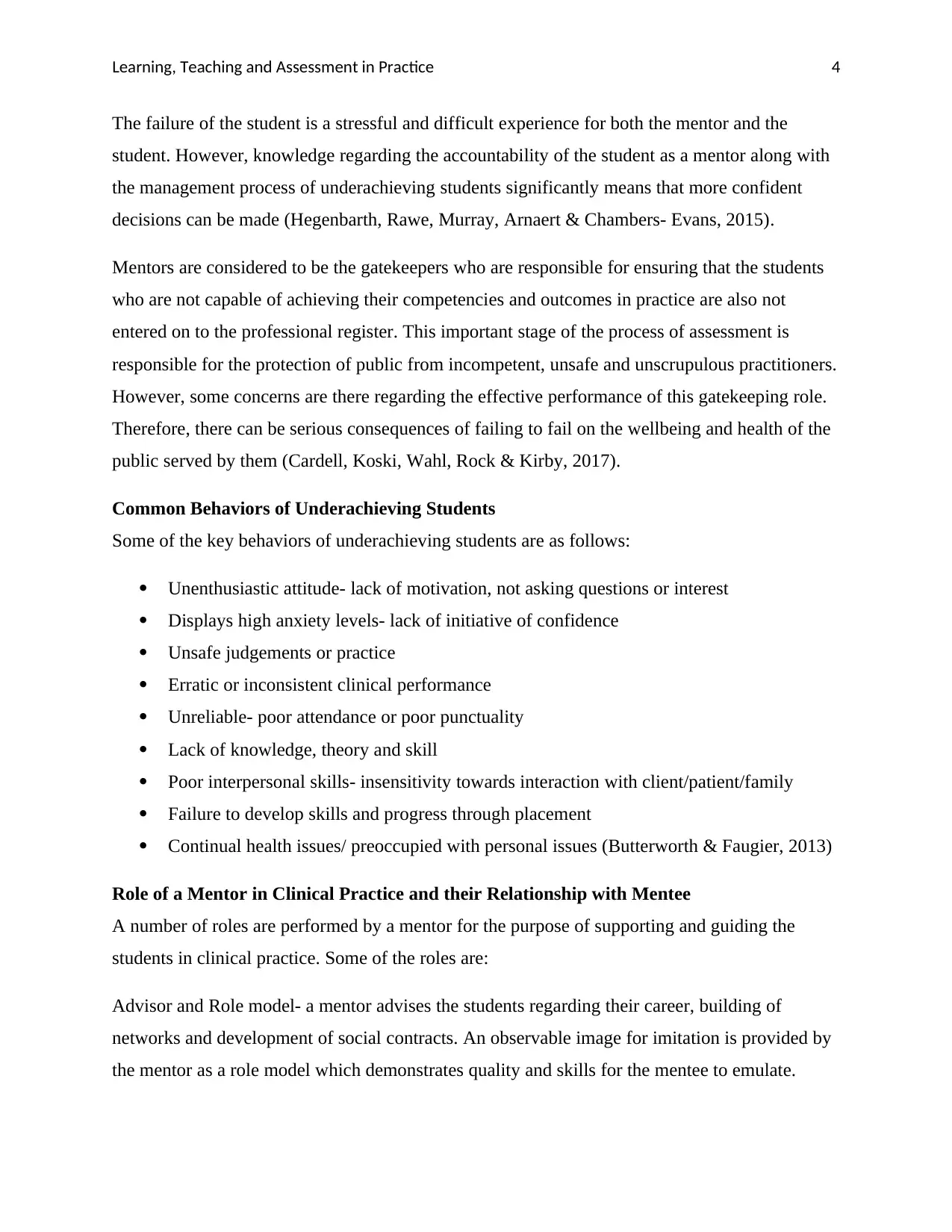
Learning, Teaching and Assessment in Practice 4
The failure of the student is a stressful and difficult experience for both the mentor and the
student. However, knowledge regarding the accountability of the student as a mentor along with
the management process of underachieving students significantly means that more confident
decisions can be made (Hegenbarth, Rawe, Murray, Arnaert & Chambers- Evans, 2015).
Mentors are considered to be the gatekeepers who are responsible for ensuring that the students
who are not capable of achieving their competencies and outcomes in practice are also not
entered on to the professional register. This important stage of the process of assessment is
responsible for the protection of public from incompetent, unsafe and unscrupulous practitioners.
However, some concerns are there regarding the effective performance of this gatekeeping role.
Therefore, there can be serious consequences of failing to fail on the wellbeing and health of the
public served by them (Cardell, Koski, Wahl, Rock & Kirby, 2017).
Common Behaviors of Underachieving Students
Some of the key behaviors of underachieving students are as follows:
Unenthusiastic attitude- lack of motivation, not asking questions or interest
Displays high anxiety levels- lack of initiative of confidence
Unsafe judgements or practice
Erratic or inconsistent clinical performance
Unreliable- poor attendance or poor punctuality
Lack of knowledge, theory and skill
Poor interpersonal skills- insensitivity towards interaction with client/patient/family
Failure to develop skills and progress through placement
Continual health issues/ preoccupied with personal issues (Butterworth & Faugier, 2013)
Role of a Mentor in Clinical Practice and their Relationship with Mentee
A number of roles are performed by a mentor for the purpose of supporting and guiding the
students in clinical practice. Some of the roles are:
Advisor and Role model- a mentor advises the students regarding their career, building of
networks and development of social contracts. An observable image for imitation is provided by
the mentor as a role model which demonstrates quality and skills for the mentee to emulate.
The failure of the student is a stressful and difficult experience for both the mentor and the
student. However, knowledge regarding the accountability of the student as a mentor along with
the management process of underachieving students significantly means that more confident
decisions can be made (Hegenbarth, Rawe, Murray, Arnaert & Chambers- Evans, 2015).
Mentors are considered to be the gatekeepers who are responsible for ensuring that the students
who are not capable of achieving their competencies and outcomes in practice are also not
entered on to the professional register. This important stage of the process of assessment is
responsible for the protection of public from incompetent, unsafe and unscrupulous practitioners.
However, some concerns are there regarding the effective performance of this gatekeeping role.
Therefore, there can be serious consequences of failing to fail on the wellbeing and health of the
public served by them (Cardell, Koski, Wahl, Rock & Kirby, 2017).
Common Behaviors of Underachieving Students
Some of the key behaviors of underachieving students are as follows:
Unenthusiastic attitude- lack of motivation, not asking questions or interest
Displays high anxiety levels- lack of initiative of confidence
Unsafe judgements or practice
Erratic or inconsistent clinical performance
Unreliable- poor attendance or poor punctuality
Lack of knowledge, theory and skill
Poor interpersonal skills- insensitivity towards interaction with client/patient/family
Failure to develop skills and progress through placement
Continual health issues/ preoccupied with personal issues (Butterworth & Faugier, 2013)
Role of a Mentor in Clinical Practice and their Relationship with Mentee
A number of roles are performed by a mentor for the purpose of supporting and guiding the
students in clinical practice. Some of the roles are:
Advisor and Role model- a mentor advises the students regarding their career, building of
networks and development of social contracts. An observable image for imitation is provided by
the mentor as a role model which demonstrates quality and skills for the mentee to emulate.
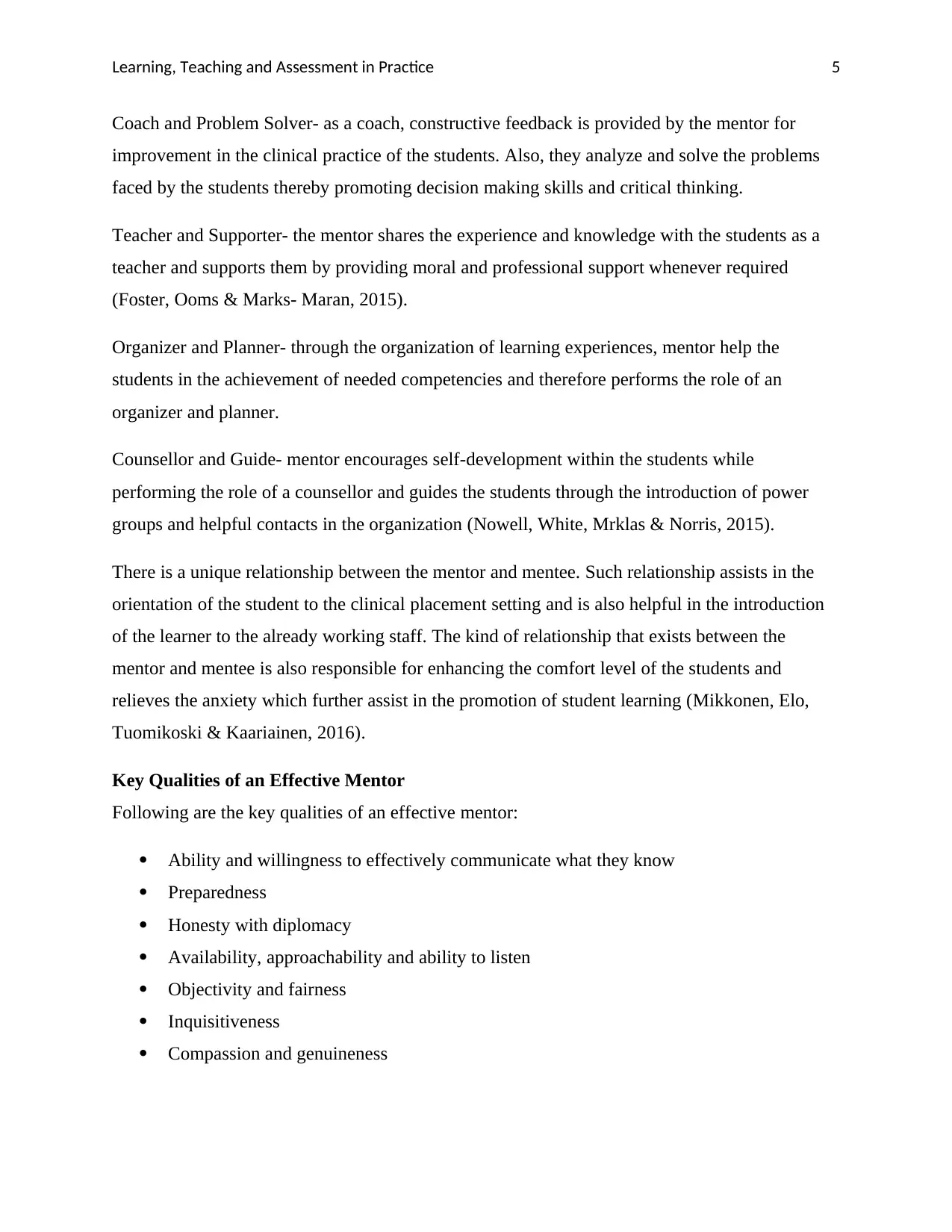
Learning, Teaching and Assessment in Practice 5
Coach and Problem Solver- as a coach, constructive feedback is provided by the mentor for
improvement in the clinical practice of the students. Also, they analyze and solve the problems
faced by the students thereby promoting decision making skills and critical thinking.
Teacher and Supporter- the mentor shares the experience and knowledge with the students as a
teacher and supports them by providing moral and professional support whenever required
(Foster, Ooms & Marks- Maran, 2015).
Organizer and Planner- through the organization of learning experiences, mentor help the
students in the achievement of needed competencies and therefore performs the role of an
organizer and planner.
Counsellor and Guide- mentor encourages self-development within the students while
performing the role of a counsellor and guides the students through the introduction of power
groups and helpful contacts in the organization (Nowell, White, Mrklas & Norris, 2015).
There is a unique relationship between the mentor and mentee. Such relationship assists in the
orientation of the student to the clinical placement setting and is also helpful in the introduction
of the learner to the already working staff. The kind of relationship that exists between the
mentor and mentee is also responsible for enhancing the comfort level of the students and
relieves the anxiety which further assist in the promotion of student learning (Mikkonen, Elo,
Tuomikoski & Kaariainen, 2016).
Key Qualities of an Effective Mentor
Following are the key qualities of an effective mentor:
Ability and willingness to effectively communicate what they know
Preparedness
Honesty with diplomacy
Availability, approachability and ability to listen
Objectivity and fairness
Inquisitiveness
Compassion and genuineness
Coach and Problem Solver- as a coach, constructive feedback is provided by the mentor for
improvement in the clinical practice of the students. Also, they analyze and solve the problems
faced by the students thereby promoting decision making skills and critical thinking.
Teacher and Supporter- the mentor shares the experience and knowledge with the students as a
teacher and supports them by providing moral and professional support whenever required
(Foster, Ooms & Marks- Maran, 2015).
Organizer and Planner- through the organization of learning experiences, mentor help the
students in the achievement of needed competencies and therefore performs the role of an
organizer and planner.
Counsellor and Guide- mentor encourages self-development within the students while
performing the role of a counsellor and guides the students through the introduction of power
groups and helpful contacts in the organization (Nowell, White, Mrklas & Norris, 2015).
There is a unique relationship between the mentor and mentee. Such relationship assists in the
orientation of the student to the clinical placement setting and is also helpful in the introduction
of the learner to the already working staff. The kind of relationship that exists between the
mentor and mentee is also responsible for enhancing the comfort level of the students and
relieves the anxiety which further assist in the promotion of student learning (Mikkonen, Elo,
Tuomikoski & Kaariainen, 2016).
Key Qualities of an Effective Mentor
Following are the key qualities of an effective mentor:
Ability and willingness to effectively communicate what they know
Preparedness
Honesty with diplomacy
Availability, approachability and ability to listen
Objectivity and fairness
Inquisitiveness
Compassion and genuineness
⊘ This is a preview!⊘
Do you want full access?
Subscribe today to unlock all pages.

Trusted by 1+ million students worldwide
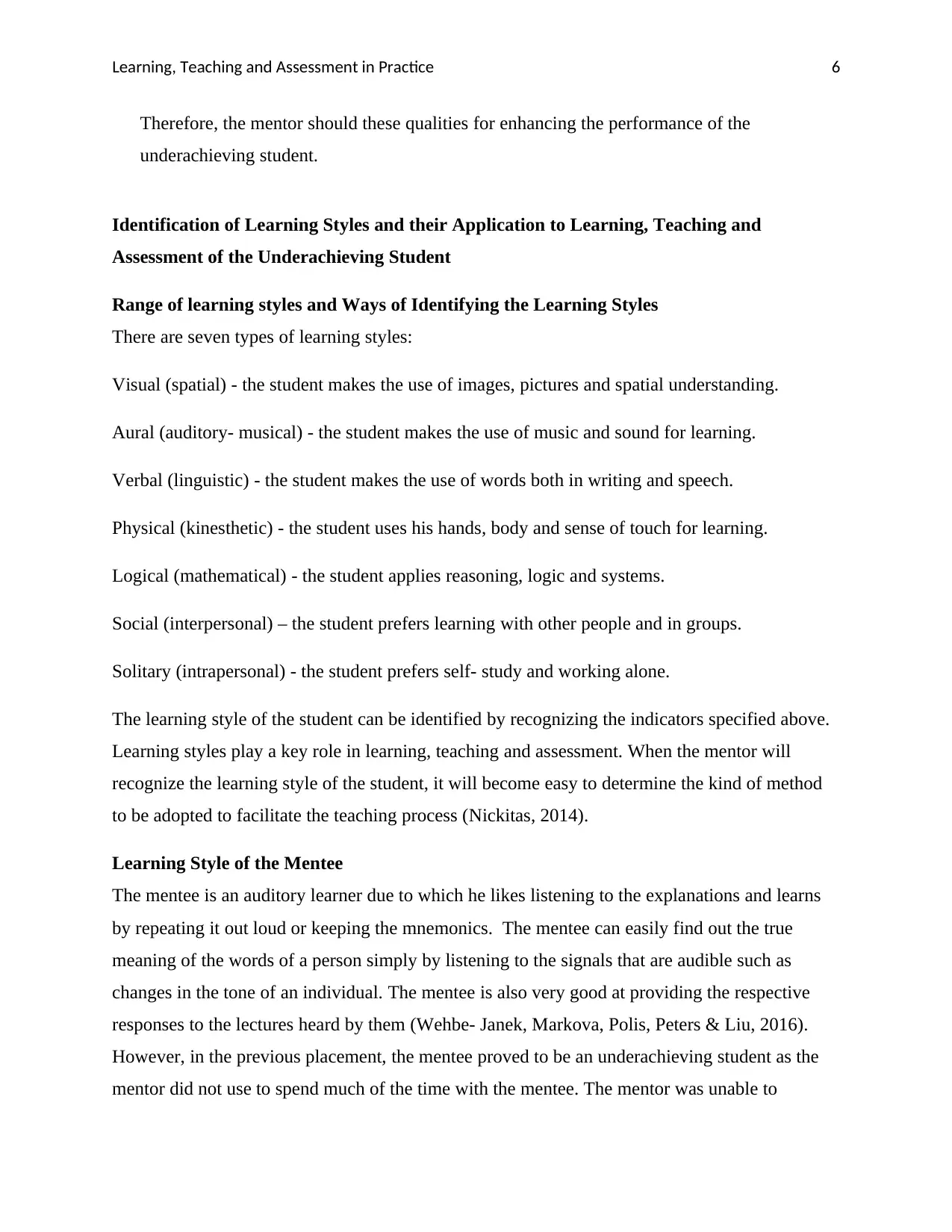
Learning, Teaching and Assessment in Practice 6
Therefore, the mentor should these qualities for enhancing the performance of the
underachieving student.
Identification of Learning Styles and their Application to Learning, Teaching and
Assessment of the Underachieving Student
Range of learning styles and Ways of Identifying the Learning Styles
There are seven types of learning styles:
Visual (spatial) - the student makes the use of images, pictures and spatial understanding.
Aural (auditory- musical) - the student makes the use of music and sound for learning.
Verbal (linguistic) - the student makes the use of words both in writing and speech.
Physical (kinesthetic) - the student uses his hands, body and sense of touch for learning.
Logical (mathematical) - the student applies reasoning, logic and systems.
Social (interpersonal) – the student prefers learning with other people and in groups.
Solitary (intrapersonal) - the student prefers self- study and working alone.
The learning style of the student can be identified by recognizing the indicators specified above.
Learning styles play a key role in learning, teaching and assessment. When the mentor will
recognize the learning style of the student, it will become easy to determine the kind of method
to be adopted to facilitate the teaching process (Nickitas, 2014).
Learning Style of the Mentee
The mentee is an auditory learner due to which he likes listening to the explanations and learns
by repeating it out loud or keeping the mnemonics. The mentee can easily find out the true
meaning of the words of a person simply by listening to the signals that are audible such as
changes in the tone of an individual. The mentee is also very good at providing the respective
responses to the lectures heard by them (Wehbe- Janek, Markova, Polis, Peters & Liu, 2016).
However, in the previous placement, the mentee proved to be an underachieving student as the
mentor did not use to spend much of the time with the mentee. The mentor was unable to
Therefore, the mentor should these qualities for enhancing the performance of the
underachieving student.
Identification of Learning Styles and their Application to Learning, Teaching and
Assessment of the Underachieving Student
Range of learning styles and Ways of Identifying the Learning Styles
There are seven types of learning styles:
Visual (spatial) - the student makes the use of images, pictures and spatial understanding.
Aural (auditory- musical) - the student makes the use of music and sound for learning.
Verbal (linguistic) - the student makes the use of words both in writing and speech.
Physical (kinesthetic) - the student uses his hands, body and sense of touch for learning.
Logical (mathematical) - the student applies reasoning, logic and systems.
Social (interpersonal) – the student prefers learning with other people and in groups.
Solitary (intrapersonal) - the student prefers self- study and working alone.
The learning style of the student can be identified by recognizing the indicators specified above.
Learning styles play a key role in learning, teaching and assessment. When the mentor will
recognize the learning style of the student, it will become easy to determine the kind of method
to be adopted to facilitate the teaching process (Nickitas, 2014).
Learning Style of the Mentee
The mentee is an auditory learner due to which he likes listening to the explanations and learns
by repeating it out loud or keeping the mnemonics. The mentee can easily find out the true
meaning of the words of a person simply by listening to the signals that are audible such as
changes in the tone of an individual. The mentee is also very good at providing the respective
responses to the lectures heard by them (Wehbe- Janek, Markova, Polis, Peters & Liu, 2016).
However, in the previous placement, the mentee proved to be an underachieving student as the
mentor did not use to spend much of the time with the mentee. The mentor was unable to
Paraphrase This Document
Need a fresh take? Get an instant paraphrase of this document with our AI Paraphraser
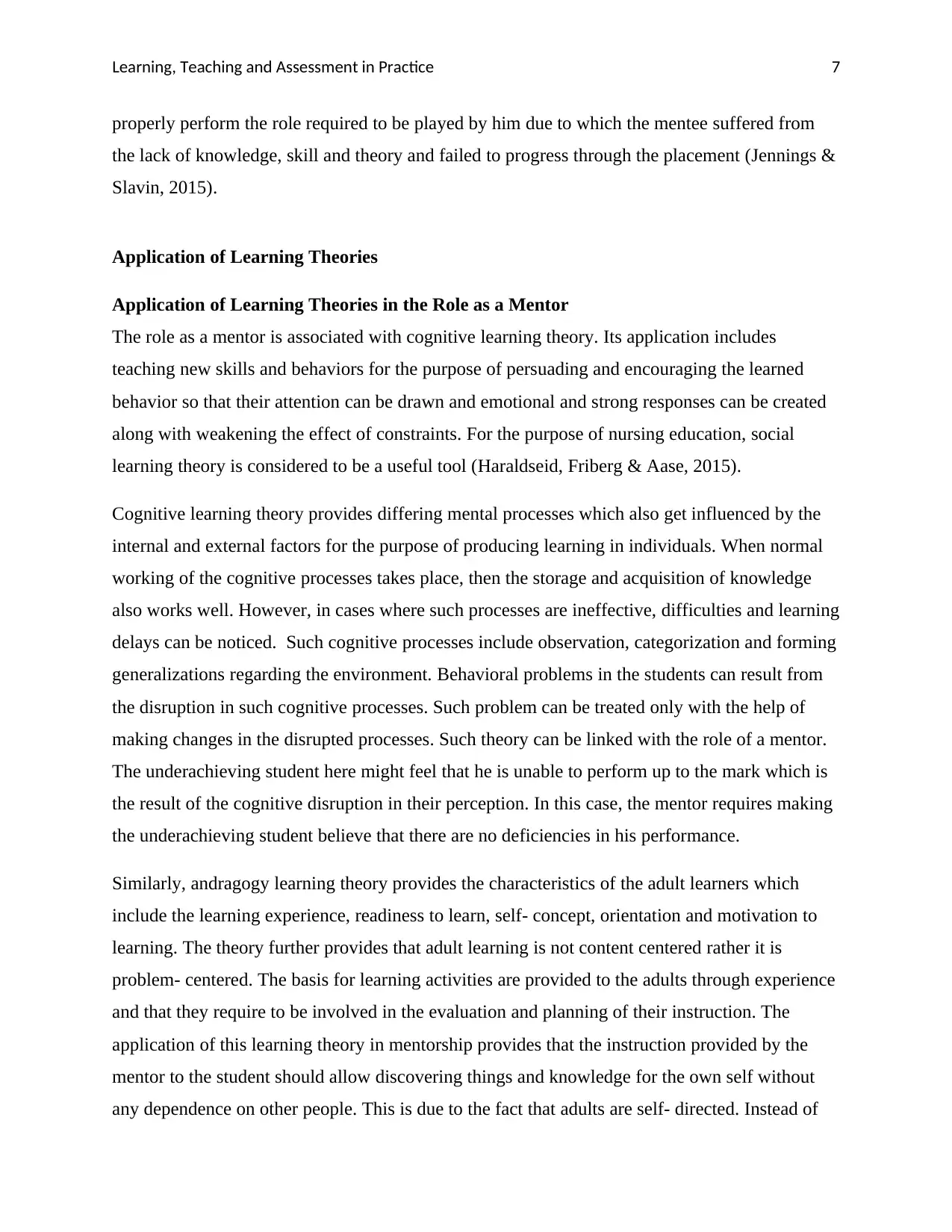
Learning, Teaching and Assessment in Practice 7
properly perform the role required to be played by him due to which the mentee suffered from
the lack of knowledge, skill and theory and failed to progress through the placement (Jennings &
Slavin, 2015).
Application of Learning Theories
Application of Learning Theories in the Role as a Mentor
The role as a mentor is associated with cognitive learning theory. Its application includes
teaching new skills and behaviors for the purpose of persuading and encouraging the learned
behavior so that their attention can be drawn and emotional and strong responses can be created
along with weakening the effect of constraints. For the purpose of nursing education, social
learning theory is considered to be a useful tool (Haraldseid, Friberg & Aase, 2015).
Cognitive learning theory provides differing mental processes which also get influenced by the
internal and external factors for the purpose of producing learning in individuals. When normal
working of the cognitive processes takes place, then the storage and acquisition of knowledge
also works well. However, in cases where such processes are ineffective, difficulties and learning
delays can be noticed. Such cognitive processes include observation, categorization and forming
generalizations regarding the environment. Behavioral problems in the students can result from
the disruption in such cognitive processes. Such problem can be treated only with the help of
making changes in the disrupted processes. Such theory can be linked with the role of a mentor.
The underachieving student here might feel that he is unable to perform up to the mark which is
the result of the cognitive disruption in their perception. In this case, the mentor requires making
the underachieving student believe that there are no deficiencies in his performance.
Similarly, andragogy learning theory provides the characteristics of the adult learners which
include the learning experience, readiness to learn, self- concept, orientation and motivation to
learning. The theory further provides that adult learning is not content centered rather it is
problem- centered. The basis for learning activities are provided to the adults through experience
and that they require to be involved in the evaluation and planning of their instruction. The
application of this learning theory in mentorship provides that the instruction provided by the
mentor to the student should allow discovering things and knowledge for the own self without
any dependence on other people. This is due to the fact that adults are self- directed. Instead of
properly perform the role required to be played by him due to which the mentee suffered from
the lack of knowledge, skill and theory and failed to progress through the placement (Jennings &
Slavin, 2015).
Application of Learning Theories
Application of Learning Theories in the Role as a Mentor
The role as a mentor is associated with cognitive learning theory. Its application includes
teaching new skills and behaviors for the purpose of persuading and encouraging the learned
behavior so that their attention can be drawn and emotional and strong responses can be created
along with weakening the effect of constraints. For the purpose of nursing education, social
learning theory is considered to be a useful tool (Haraldseid, Friberg & Aase, 2015).
Cognitive learning theory provides differing mental processes which also get influenced by the
internal and external factors for the purpose of producing learning in individuals. When normal
working of the cognitive processes takes place, then the storage and acquisition of knowledge
also works well. However, in cases where such processes are ineffective, difficulties and learning
delays can be noticed. Such cognitive processes include observation, categorization and forming
generalizations regarding the environment. Behavioral problems in the students can result from
the disruption in such cognitive processes. Such problem can be treated only with the help of
making changes in the disrupted processes. Such theory can be linked with the role of a mentor.
The underachieving student here might feel that he is unable to perform up to the mark which is
the result of the cognitive disruption in their perception. In this case, the mentor requires making
the underachieving student believe that there are no deficiencies in his performance.
Similarly, andragogy learning theory provides the characteristics of the adult learners which
include the learning experience, readiness to learn, self- concept, orientation and motivation to
learning. The theory further provides that adult learning is not content centered rather it is
problem- centered. The basis for learning activities are provided to the adults through experience
and that they require to be involved in the evaluation and planning of their instruction. The
application of this learning theory in mentorship provides that the instruction provided by the
mentor to the student should allow discovering things and knowledge for the own self without
any dependence on other people. This is due to the fact that adults are self- directed. Instead of
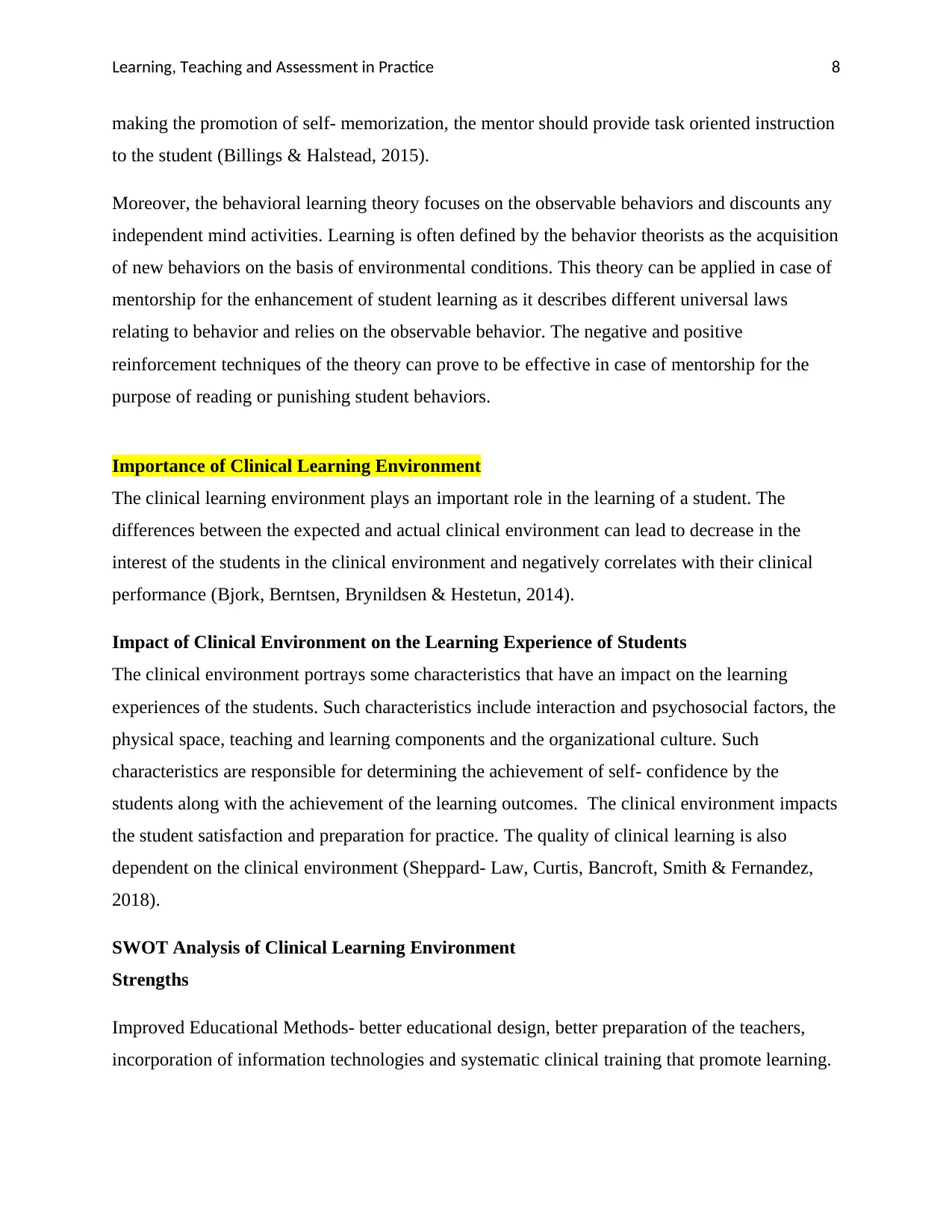
Learning, Teaching and Assessment in Practice 8
making the promotion of self- memorization, the mentor should provide task oriented instruction
to the student (Billings & Halstead, 2015).
Moreover, the behavioral learning theory focuses on the observable behaviors and discounts any
independent mind activities. Learning is often defined by the behavior theorists as the acquisition
of new behaviors on the basis of environmental conditions. This theory can be applied in case of
mentorship for the enhancement of student learning as it describes different universal laws
relating to behavior and relies on the observable behavior. The negative and positive
reinforcement techniques of the theory can prove to be effective in case of mentorship for the
purpose of reading or punishing student behaviors.
Importance of Clinical Learning Environment
The clinical learning environment plays an important role in the learning of a student. The
differences between the expected and actual clinical environment can lead to decrease in the
interest of the students in the clinical environment and negatively correlates with their clinical
performance (Bjork, Berntsen, Brynildsen & Hestetun, 2014).
Impact of Clinical Environment on the Learning Experience of Students
The clinical environment portrays some characteristics that have an impact on the learning
experiences of the students. Such characteristics include interaction and psychosocial factors, the
physical space, teaching and learning components and the organizational culture. Such
characteristics are responsible for determining the achievement of self- confidence by the
students along with the achievement of the learning outcomes. The clinical environment impacts
the student satisfaction and preparation for practice. The quality of clinical learning is also
dependent on the clinical environment (Sheppard- Law, Curtis, Bancroft, Smith & Fernandez,
2018).
SWOT Analysis of Clinical Learning Environment
Strengths
Improved Educational Methods- better educational design, better preparation of the teachers,
incorporation of information technologies and systematic clinical training that promote learning.
making the promotion of self- memorization, the mentor should provide task oriented instruction
to the student (Billings & Halstead, 2015).
Moreover, the behavioral learning theory focuses on the observable behaviors and discounts any
independent mind activities. Learning is often defined by the behavior theorists as the acquisition
of new behaviors on the basis of environmental conditions. This theory can be applied in case of
mentorship for the enhancement of student learning as it describes different universal laws
relating to behavior and relies on the observable behavior. The negative and positive
reinforcement techniques of the theory can prove to be effective in case of mentorship for the
purpose of reading or punishing student behaviors.
Importance of Clinical Learning Environment
The clinical learning environment plays an important role in the learning of a student. The
differences between the expected and actual clinical environment can lead to decrease in the
interest of the students in the clinical environment and negatively correlates with their clinical
performance (Bjork, Berntsen, Brynildsen & Hestetun, 2014).
Impact of Clinical Environment on the Learning Experience of Students
The clinical environment portrays some characteristics that have an impact on the learning
experiences of the students. Such characteristics include interaction and psychosocial factors, the
physical space, teaching and learning components and the organizational culture. Such
characteristics are responsible for determining the achievement of self- confidence by the
students along with the achievement of the learning outcomes. The clinical environment impacts
the student satisfaction and preparation for practice. The quality of clinical learning is also
dependent on the clinical environment (Sheppard- Law, Curtis, Bancroft, Smith & Fernandez,
2018).
SWOT Analysis of Clinical Learning Environment
Strengths
Improved Educational Methods- better educational design, better preparation of the teachers,
incorporation of information technologies and systematic clinical training that promote learning.
⊘ This is a preview!⊘
Do you want full access?
Subscribe today to unlock all pages.

Trusted by 1+ million students worldwide
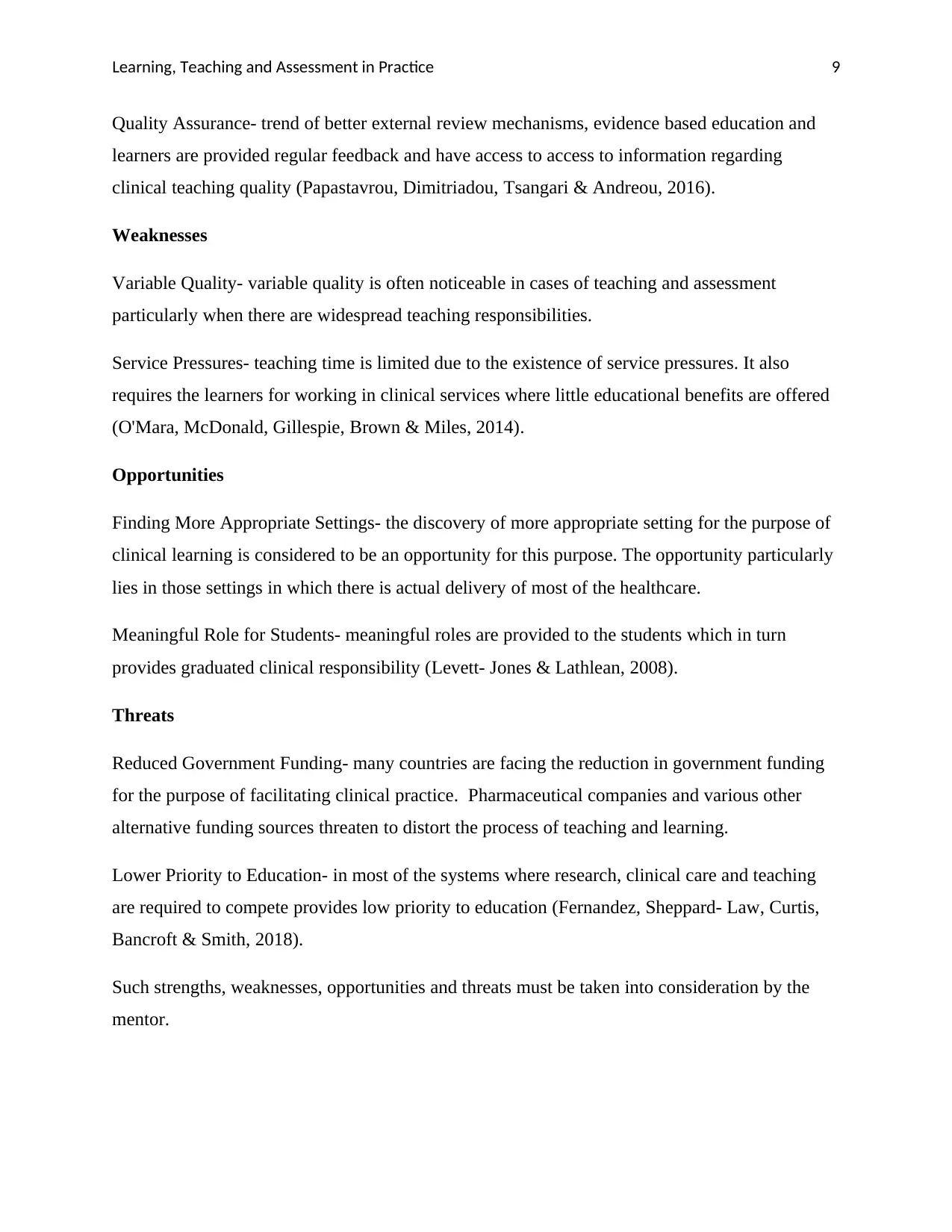
Learning, Teaching and Assessment in Practice 9
Quality Assurance- trend of better external review mechanisms, evidence based education and
learners are provided regular feedback and have access to access to information regarding
clinical teaching quality (Papastavrou, Dimitriadou, Tsangari & Andreou, 2016).
Weaknesses
Variable Quality- variable quality is often noticeable in cases of teaching and assessment
particularly when there are widespread teaching responsibilities.
Service Pressures- teaching time is limited due to the existence of service pressures. It also
requires the learners for working in clinical services where little educational benefits are offered
(O'Mara, McDonald, Gillespie, Brown & Miles, 2014).
Opportunities
Finding More Appropriate Settings- the discovery of more appropriate setting for the purpose of
clinical learning is considered to be an opportunity for this purpose. The opportunity particularly
lies in those settings in which there is actual delivery of most of the healthcare.
Meaningful Role for Students- meaningful roles are provided to the students which in turn
provides graduated clinical responsibility (Levett- Jones & Lathlean, 2008).
Threats
Reduced Government Funding- many countries are facing the reduction in government funding
for the purpose of facilitating clinical practice. Pharmaceutical companies and various other
alternative funding sources threaten to distort the process of teaching and learning.
Lower Priority to Education- in most of the systems where research, clinical care and teaching
are required to compete provides low priority to education (Fernandez, Sheppard- Law, Curtis,
Bancroft & Smith, 2018).
Such strengths, weaknesses, opportunities and threats must be taken into consideration by the
mentor.
Quality Assurance- trend of better external review mechanisms, evidence based education and
learners are provided regular feedback and have access to access to information regarding
clinical teaching quality (Papastavrou, Dimitriadou, Tsangari & Andreou, 2016).
Weaknesses
Variable Quality- variable quality is often noticeable in cases of teaching and assessment
particularly when there are widespread teaching responsibilities.
Service Pressures- teaching time is limited due to the existence of service pressures. It also
requires the learners for working in clinical services where little educational benefits are offered
(O'Mara, McDonald, Gillespie, Brown & Miles, 2014).
Opportunities
Finding More Appropriate Settings- the discovery of more appropriate setting for the purpose of
clinical learning is considered to be an opportunity for this purpose. The opportunity particularly
lies in those settings in which there is actual delivery of most of the healthcare.
Meaningful Role for Students- meaningful roles are provided to the students which in turn
provides graduated clinical responsibility (Levett- Jones & Lathlean, 2008).
Threats
Reduced Government Funding- many countries are facing the reduction in government funding
for the purpose of facilitating clinical practice. Pharmaceutical companies and various other
alternative funding sources threaten to distort the process of teaching and learning.
Lower Priority to Education- in most of the systems where research, clinical care and teaching
are required to compete provides low priority to education (Fernandez, Sheppard- Law, Curtis,
Bancroft & Smith, 2018).
Such strengths, weaknesses, opportunities and threats must be taken into consideration by the
mentor.
Paraphrase This Document
Need a fresh take? Get an instant paraphrase of this document with our AI Paraphraser
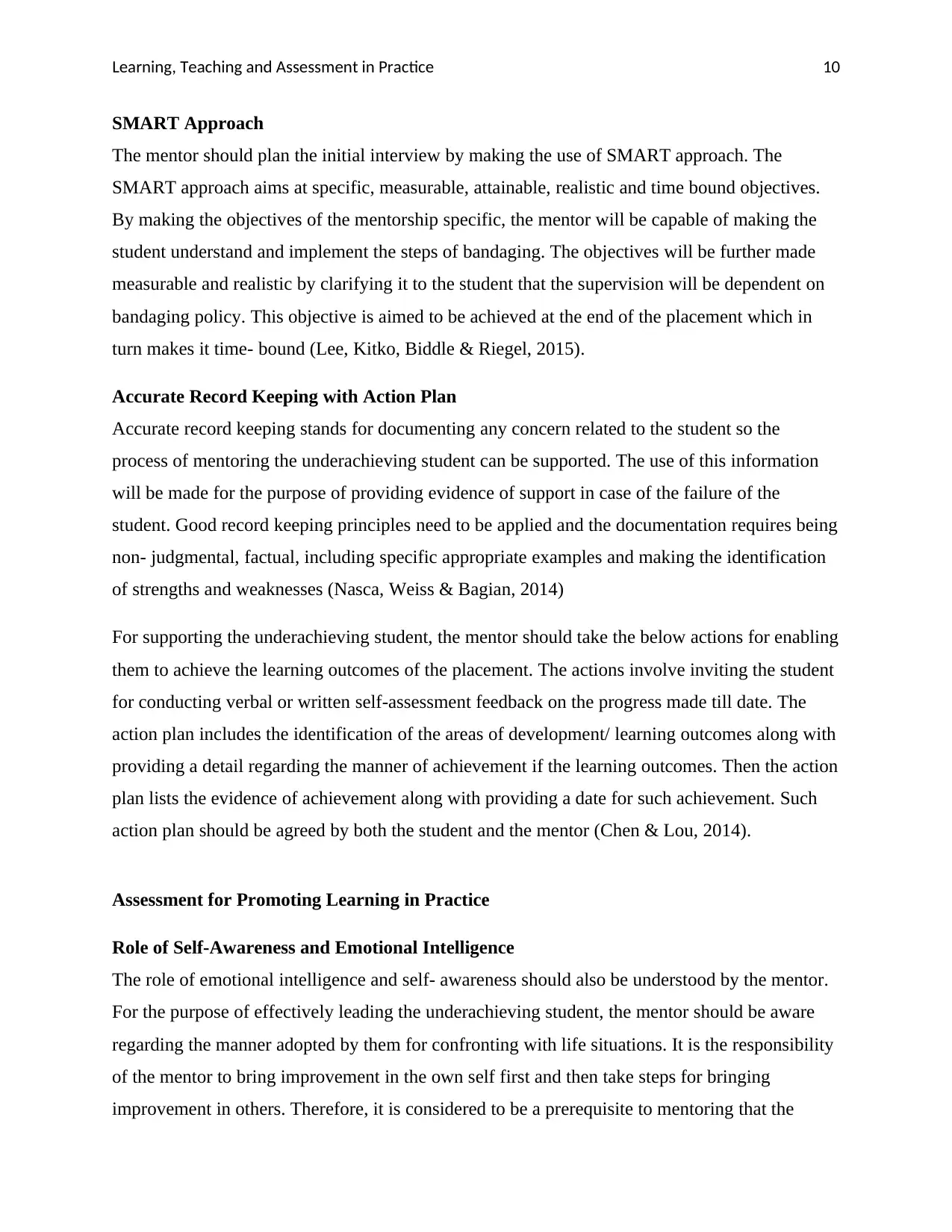
Learning, Teaching and Assessment in Practice 10
SMART Approach
The mentor should plan the initial interview by making the use of SMART approach. The
SMART approach aims at specific, measurable, attainable, realistic and time bound objectives.
By making the objectives of the mentorship specific, the mentor will be capable of making the
student understand and implement the steps of bandaging. The objectives will be further made
measurable and realistic by clarifying it to the student that the supervision will be dependent on
bandaging policy. This objective is aimed to be achieved at the end of the placement which in
turn makes it time- bound (Lee, Kitko, Biddle & Riegel, 2015).
Accurate Record Keeping with Action Plan
Accurate record keeping stands for documenting any concern related to the student so the
process of mentoring the underachieving student can be supported. The use of this information
will be made for the purpose of providing evidence of support in case of the failure of the
student. Good record keeping principles need to be applied and the documentation requires being
non- judgmental, factual, including specific appropriate examples and making the identification
of strengths and weaknesses (Nasca, Weiss & Bagian, 2014)
For supporting the underachieving student, the mentor should take the below actions for enabling
them to achieve the learning outcomes of the placement. The actions involve inviting the student
for conducting verbal or written self-assessment feedback on the progress made till date. The
action plan includes the identification of the areas of development/ learning outcomes along with
providing a detail regarding the manner of achievement if the learning outcomes. Then the action
plan lists the evidence of achievement along with providing a date for such achievement. Such
action plan should be agreed by both the student and the mentor (Chen & Lou, 2014).
Assessment for Promoting Learning in Practice
Role of Self-Awareness and Emotional Intelligence
The role of emotional intelligence and self- awareness should also be understood by the mentor.
For the purpose of effectively leading the underachieving student, the mentor should be aware
regarding the manner adopted by them for confronting with life situations. It is the responsibility
of the mentor to bring improvement in the own self first and then take steps for bringing
improvement in others. Therefore, it is considered to be a prerequisite to mentoring that the
SMART Approach
The mentor should plan the initial interview by making the use of SMART approach. The
SMART approach aims at specific, measurable, attainable, realistic and time bound objectives.
By making the objectives of the mentorship specific, the mentor will be capable of making the
student understand and implement the steps of bandaging. The objectives will be further made
measurable and realistic by clarifying it to the student that the supervision will be dependent on
bandaging policy. This objective is aimed to be achieved at the end of the placement which in
turn makes it time- bound (Lee, Kitko, Biddle & Riegel, 2015).
Accurate Record Keeping with Action Plan
Accurate record keeping stands for documenting any concern related to the student so the
process of mentoring the underachieving student can be supported. The use of this information
will be made for the purpose of providing evidence of support in case of the failure of the
student. Good record keeping principles need to be applied and the documentation requires being
non- judgmental, factual, including specific appropriate examples and making the identification
of strengths and weaknesses (Nasca, Weiss & Bagian, 2014)
For supporting the underachieving student, the mentor should take the below actions for enabling
them to achieve the learning outcomes of the placement. The actions involve inviting the student
for conducting verbal or written self-assessment feedback on the progress made till date. The
action plan includes the identification of the areas of development/ learning outcomes along with
providing a detail regarding the manner of achievement if the learning outcomes. Then the action
plan lists the evidence of achievement along with providing a date for such achievement. Such
action plan should be agreed by both the student and the mentor (Chen & Lou, 2014).
Assessment for Promoting Learning in Practice
Role of Self-Awareness and Emotional Intelligence
The role of emotional intelligence and self- awareness should also be understood by the mentor.
For the purpose of effectively leading the underachieving student, the mentor should be aware
regarding the manner adopted by them for confronting with life situations. It is the responsibility
of the mentor to bring improvement in the own self first and then take steps for bringing
improvement in others. Therefore, it is considered to be a prerequisite to mentoring that the
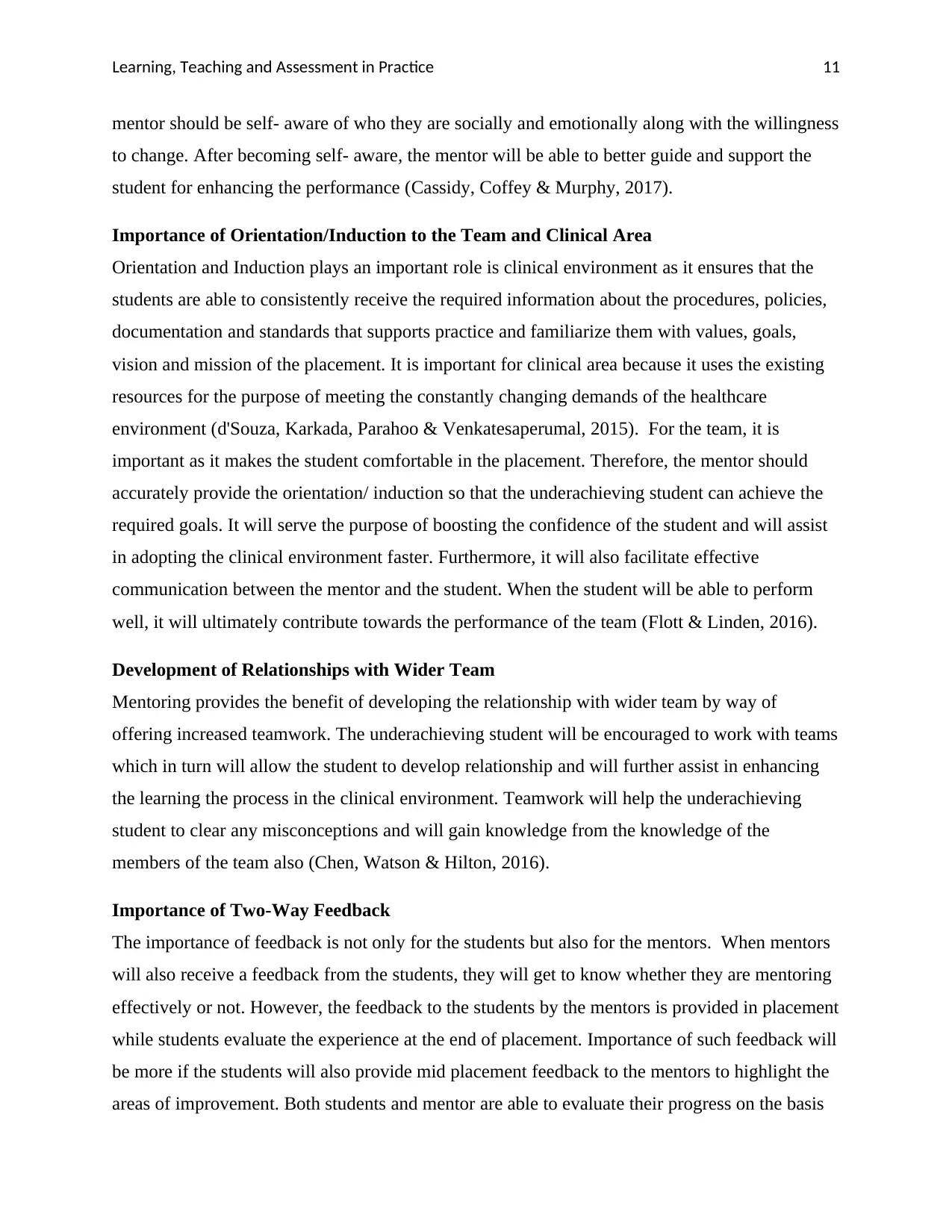
Learning, Teaching and Assessment in Practice 11
mentor should be self- aware of who they are socially and emotionally along with the willingness
to change. After becoming self- aware, the mentor will be able to better guide and support the
student for enhancing the performance (Cassidy, Coffey & Murphy, 2017).
Importance of Orientation/Induction to the Team and Clinical Area
Orientation and Induction plays an important role is clinical environment as it ensures that the
students are able to consistently receive the required information about the procedures, policies,
documentation and standards that supports practice and familiarize them with values, goals,
vision and mission of the placement. It is important for clinical area because it uses the existing
resources for the purpose of meeting the constantly changing demands of the healthcare
environment (d'Souza, Karkada, Parahoo & Venkatesaperumal, 2015). For the team, it is
important as it makes the student comfortable in the placement. Therefore, the mentor should
accurately provide the orientation/ induction so that the underachieving student can achieve the
required goals. It will serve the purpose of boosting the confidence of the student and will assist
in adopting the clinical environment faster. Furthermore, it will also facilitate effective
communication between the mentor and the student. When the student will be able to perform
well, it will ultimately contribute towards the performance of the team (Flott & Linden, 2016).
Development of Relationships with Wider Team
Mentoring provides the benefit of developing the relationship with wider team by way of
offering increased teamwork. The underachieving student will be encouraged to work with teams
which in turn will allow the student to develop relationship and will further assist in enhancing
the learning the process in the clinical environment. Teamwork will help the underachieving
student to clear any misconceptions and will gain knowledge from the knowledge of the
members of the team also (Chen, Watson & Hilton, 2016).
Importance of Two-Way Feedback
The importance of feedback is not only for the students but also for the mentors. When mentors
will also receive a feedback from the students, they will get to know whether they are mentoring
effectively or not. However, the feedback to the students by the mentors is provided in placement
while students evaluate the experience at the end of placement. Importance of such feedback will
be more if the students will also provide mid placement feedback to the mentors to highlight the
areas of improvement. Both students and mentor are able to evaluate their progress on the basis
mentor should be self- aware of who they are socially and emotionally along with the willingness
to change. After becoming self- aware, the mentor will be able to better guide and support the
student for enhancing the performance (Cassidy, Coffey & Murphy, 2017).
Importance of Orientation/Induction to the Team and Clinical Area
Orientation and Induction plays an important role is clinical environment as it ensures that the
students are able to consistently receive the required information about the procedures, policies,
documentation and standards that supports practice and familiarize them with values, goals,
vision and mission of the placement. It is important for clinical area because it uses the existing
resources for the purpose of meeting the constantly changing demands of the healthcare
environment (d'Souza, Karkada, Parahoo & Venkatesaperumal, 2015). For the team, it is
important as it makes the student comfortable in the placement. Therefore, the mentor should
accurately provide the orientation/ induction so that the underachieving student can achieve the
required goals. It will serve the purpose of boosting the confidence of the student and will assist
in adopting the clinical environment faster. Furthermore, it will also facilitate effective
communication between the mentor and the student. When the student will be able to perform
well, it will ultimately contribute towards the performance of the team (Flott & Linden, 2016).
Development of Relationships with Wider Team
Mentoring provides the benefit of developing the relationship with wider team by way of
offering increased teamwork. The underachieving student will be encouraged to work with teams
which in turn will allow the student to develop relationship and will further assist in enhancing
the learning the process in the clinical environment. Teamwork will help the underachieving
student to clear any misconceptions and will gain knowledge from the knowledge of the
members of the team also (Chen, Watson & Hilton, 2016).
Importance of Two-Way Feedback
The importance of feedback is not only for the students but also for the mentors. When mentors
will also receive a feedback from the students, they will get to know whether they are mentoring
effectively or not. However, the feedback to the students by the mentors is provided in placement
while students evaluate the experience at the end of placement. Importance of such feedback will
be more if the students will also provide mid placement feedback to the mentors to highlight the
areas of improvement. Both students and mentor are able to evaluate their progress on the basis
⊘ This is a preview!⊘
Do you want full access?
Subscribe today to unlock all pages.

Trusted by 1+ million students worldwide
1 out of 17
Related Documents
Your All-in-One AI-Powered Toolkit for Academic Success.
+13062052269
info@desklib.com
Available 24*7 on WhatsApp / Email
![[object Object]](/_next/static/media/star-bottom.7253800d.svg)
Unlock your academic potential
Copyright © 2020–2025 A2Z Services. All Rights Reserved. Developed and managed by ZUCOL.





